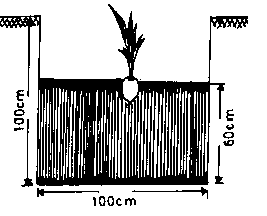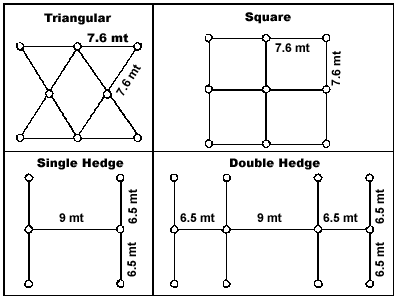|
Cultivation Practices
Selection of site
Select sites with deep (not less than 1.5 m depth) well drained soil. Avoid shallow
soils with underlying hard rock, low-lying areas subject to water stagnation and
heavy clayey soils. Proper supply of moisture either through well-distributed rainfall
or through irrigation is required.
Land preparation

|
The nature of preparation of land before planting depends upon topography of land,
soil type and other environmental factors. On slopes and in areas of undulating
terrain, prepare the land by contour terracing or bunding. In low-lying areas and
rice fields, form mounds to a height of at least 1 m above water level. In reclaimed
kayal areas, planting can be done on the field bunds.
The size of pits for planting would depend upon soil types and water table. In loamy
soils with low water table, pit size of 1 x 1 x 1 m is recommended. In laterite
soils with underlying rocks, take larger pits of size 1.2 x 1.2 x 1.2 m. In sandy
soils, the size of pits may be 0.75x 0.75 x 0.75 m. The pits may be filled up with
top soil to a height 60 cm below the ground level. In low lying lands, take shallow
pits and as the plant grows, raise the ground level by adding silt and sand so as
to cover the entire bole of the palm. The same procedure can be adopted when planting
is done on mounds or bunds. Burial of two layers of husks in the floor of the pits
will be useful for moisture conservation. The husk is to be buried in layers with
concave surface facing upwards. After arranging each layer, sprinkle carbaryl 10%
dust on the husk to prevent colonization by termites.
|
Note: In lateritic areas, common salt at the rate of 2 kg per pit may be applied
on the floor of the pit to improve soil conditions. Common salt is to be applied
about six months prior to planting.
Spacing and system of planting
Spacing depends upon the planting system, soil type etc. In general, the following
spacings are recommended under different systems in sandy and laterite soils. In
lateritic gravelly soils, under rainfed conditions of north Kerala, a closer spacing
to accommodate 250 palms per ha is more economical.
|
Planting system
|
Spacing
|
Approximate number of plants/ha
|
|
Triangular
|
7.6 m
|
198
|
|
Square
|
7.6 to 9 m
|
>170-120
|
|
Single hedge
|
5 m in the rows 9 m between the rows
|
220
|
|
Double hedge
|
5 x 5 m in rows 9 m between pairs of rows
|
280
|

In the hedge system of planting, the rows should be aligned in north-south direction
and the seedlings planted as in the triangular system.
Time of planting
Planting the seedlings during May, with the onset of pre-monsoon rains is ideal.
Under assured irrigation, planting can be done during April also. In low-lying areas,
plant the seedlings in September after the cessation of heavy rains.
Care for Young Palms
Shading and irrigation
For the first two years from planting, irrigate @ 45 litres of water per seedling,
once in 4 days, during dry summer months. Provide adequate shade to the transplanted
seedlings.
Manuring young palms
For the first three years after planting under rainfed conditions, apply fertilizers
in two split doses at the rates shown in table. Fertilizer requirement of adult
palms is given under Manuring of adult palms .
Fertilizer requirement of young palms in relation to that
of adult palms
|
Time after planting
|
Time of application
|
|
April-June
|
Sept-Oct.
|
|
(Proportion of adults palm dose)
|
|
3 months (1/10th of full dose)
|
-
|
1/10
|
|
1 year (1/3rd of full dose)
|
1/9
|
2/9
|
|
2 year (2/3rd of full dose)
|
2/9
|
4/9
|
|
3 year onwards (full dose)
|
3/9
|
6/9
|
Note: Under irrigated conditions, the fertilizers can be applied in 3-4 equal split
doses.
In the case of low lying areas, apply fertilizer after water table recedes in one
single dose or in two split doses as conditions permit. In all types of soils that
are low in organic matter content (except reclaimed clayey soils and alluvial soils),
apply organic matter @ of 15-25 kg/palm/year during June-July from the second year
of planting.
Micro Nutrient Management
Magnesium sulphate @ 0.5-1.0 kg/palm/year is recommended for root (wilt) affected
area.
For sandy and sandy loams of Onattukara and similar situations and also for hybrid
palms grown in root (wilt) affected areas, apply 500 g MgSO4/palm/year.
Apply lime or dolomite during April-May, magnesium sulphate during August- September
and organic matter during May – June. For an adult palm 1 kg dolomite or 1 kg lime
+ 0.5 kg MgSO4 is required per annum.
Weeding & Interculture
Keep the pits free of weeds by periodical weeding. Remove the soil covering the
collar of seedlings. As the seedlings grow and form stem, fill up the pits gradually
by cutting the sides. Proper intercultivation provides control of weeds and creates
soil mulch. Any tillage system (ploughing, digging, raking or forming mounds) that
provides soil mulch and control weeds may be followed depending upon local conditions.
For laterite, sandy and red sandy loam soils give two ploughings or diggings in
May-June and September-October and one raking in January. In areas where surface
run off is more, form mounds in September-October and level them in November-December.
Drought Management in Coconut Gardens
Coconut produces nuts round the year. Therefore, adequate supply of water is essential
for its unhindered growth. Soil moisture is essential for the absorption of nutrients
by roots. Moisture stress leads to stunted growth, drooping of leaves, immature
nut fall and decreased yield. Importance may be given on the following aspects so
as to ward off stress:
Husk burial for moisture conservation (Add FIGS)
Burying of fresh or dried coconut husk around the palm is a desirable practice particularly
for moisture retention. The husk can be buried either in linear trenches taken 3
m away from the trunk between rows of palms or in circular trenches taken around
the palm at a distance of 2 m from the trunk. The trenches may be of 0.5 m width
and depth. The husks are to be placed in layers with concave surface facing upwards
and covered with soil. The beneficial effect of husk burial will last for about
5-7 years. Instead of husk, coconut pith can be buried @ 25 kg / palm / year.
Mulching
Mulching is an effective method of conserving soil moisture. Mulch the coconut basins
with green / dry leaves at the close of northeast monsoon (October-November). Mulching
also adds organic matter to the soil and reduces the soil temperature. Do not disturb
soil in the coconut garden during summer months. In level lands, during rainy seasons
excess water may be conserved in small trenches dug out in the plantation. In sloppy
areas, land may be terraced and trenches dug across. This will facilitate maximum
percolation of rainwater and water storage. For moisture conservation, lowermost
3-5 leaves may be cut and removed. Provide adequate shade for the transplanted seedlings
for 1-2 years. To minimize the heat load on the stem, application of lime solution
on the trunk up to a height of 2-3 m at the start of the summer season is recommended.
Green manure and cover crops
Green manure and cover crops recommended for cultivation in coconut gardens are:
- Green manure crops: Crotalaria juncea (sunn hemp), Tephrosia purpurea
(kolinji), Indigofera hirsuta, Pueraria phaseoloides .
- Cover crops:
Calapagonium muconoides, Mimosa invisa, Stylosanthes gracilis
- Shade-cum-green
manure shrub: Tephrosia candida
Sow cowpea seeds more towards the periphery of basins taken at a radius of 2.0m
from the base of the palm for green manure during April-May with the onset of premonsoon
rains. When a few plants start flowering, uproot the entire plants and incorporate
into the soil during August- September and cover the basins with soil.
Sow green manure and cover crop seeds during April-May with the onset of pre-monsoon
rains. The green manure crops should be ploughed in and incorporated into the soil
during August- September. This will increase the water holding capacity of soil.
Calapagonium can be grown either as green manure or cover crop. Tephrosia
is especially suited for planting around seedling pits for summer shade and as a
source of green manure in the rainy season.
|